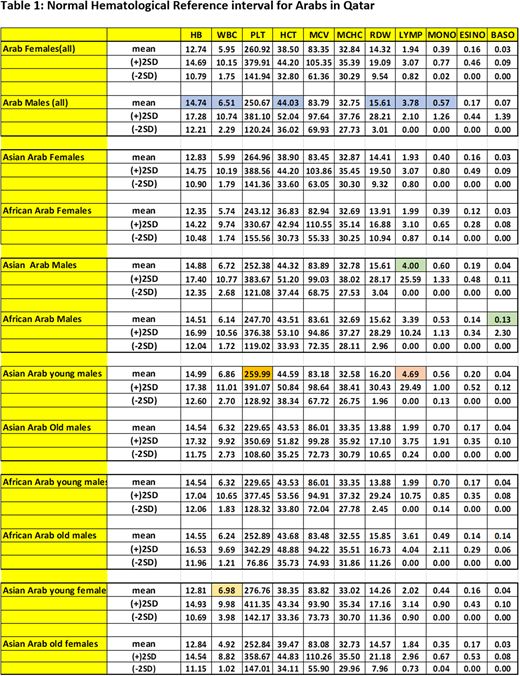Introduction:
The majority of physicians' medical judgments are based on clinical information supported by laboratory reports . The availability of a reference interval for different lab values facilitates the process of interpretation . Complete blood count (CBC), testing is one of the most frequently performed hematology test in any clinical setting. Analysis of CBC by hematology analyzers is an indispensable means in the evaluation of many acute and chronic disorders including traumatic, infectious, immunological, and hematological diseases. Establishment of a normal reference interval is essential for accurate clarification of the disease diagnosis as well as for follow up. CBC techniques have improved significantly, and the accurate automated methods have now substituted manual methods. In addition, various novel blood cell parameters have been developed alongside to aid in diagnosis and management of several blood disorders . However significant differences exist in the reference intervals based on age, gender, ethnicity, genetic differences, environmental factors, and geographical location.. Dietary habits and occupational exposures are factors that have been shown to affect reference interval . Therefore, there is a requirement for each country to establish its own reference intervals. Country-specific reference intervals for CBC of adult peripheral blood have been established in many countries around the world; however, there have been no specific comprehensive studies in Arab population in Qatar based on age, gender, geographic location and ABO blood groups. To the best of our knowledge, this is the first study in Qatar that investigated CBC reference intervals in relation to age, gender, and blood grouping which can now be used as a reference when evaluating patient samples in Qatar.
Methods:
Venous blood specimens were collected from 720 healthy randomly selected individuals aged 18 to 69 years from 2018 to 2019 and analyzed by Sysmex NX-10 and NX -20 automated hematology analyzers. Results were statistically analyzed and compared by gender, age, and ABO blood group. Arab adults were divided into African Arabs (Egypt, Libya, Tunisia, Morocco) and Asian Arabs (Syria, Lebanon, Jordon, Palestine, Qatar). The lower and upper reference limits of the hematology reference intervals were established at the -2 SD and +2SD respectively.
Results:
Reference intervals were calculated for all the hematology parameters which included red blood cell, white blood cell and differential count, and platelet parameters. Arab males had significantly higher Hb, Hct, RDW, ANC, lymphocytes and monocyte counts compared to adult females. Asian-Arab males had significantly higher Hb concentration and higher WBC, lymphocytes and eosinophil counts compared to African- Arab males. Asian Arab young males had significantly higher Hb level and lymphocyte count and lower monocytes counts compared old males. African Arab young males had significantly higher lymphocyte and lower monocytes counts compared to old males. Asian- Arab young females had higher WBC, ANC counts compared to old Asian Arab females. No statistical difference in the studied hematological parameters was detected among the three groups with different ABO subgroups
Conclusions:
Data from this study established specific reference intervals which could be considered for general use in the Arab world. The differences in hematology reference intervals in respect to age, sex and geographical location highlights the necessity to establish reference intervals for venous blood parameters among the healthy population in each country or at least in each region.
No relevant conflicts of interest to declare.
Author notes
Asterisk with author names denotes non-ASH members.


